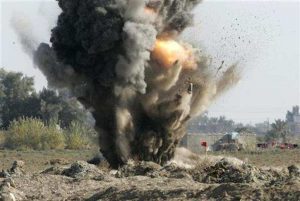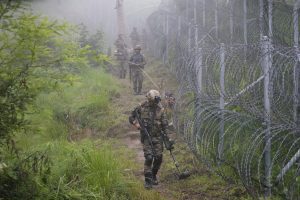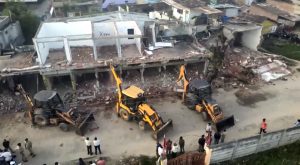Jammu & Kashmir – The Poonch Landmine Blasts near the Line of Control (LoC) on Thursday afternoon created panic among residents of border villages but fortunately caused no casualties. Officials confirmed that four landmines and a mortar shell exploded in different areas of Poonch district, all triggered by dislodged explosives from the anti-infiltration obstacle system following heavy rainfall.
According to initial reports, the Poonch Landmine Blasts occurred between Wednesday and Thursday across Forward Balakote and Mankote sectors, areas frequently impacted by cross-border tensions and harsh weather. Authorities have confirmed that the Army’s bomb disposal squad immediately launched an inspection to ensure that no unexploded ordnance remains in the vicinity.
Chronology of the Poonch Landmine Blasts

Officials said that around 3:40 pm on Thursday, a mortar shell exploded in a field belonging to a local resident, Kabir Hussain, in Sagra village under Tehsil Mankote. Hussain, who was using a JCB machine to excavate his land, narrowly escaped unhurt as the shell detonated during digging. The mortar shell is believed to have remained unexploded since previous episodes of cross-border firing, later disturbed by weather-induced ground movement leading to the Poonch Landmine Blasts sequence.
On Wednesday afternoon, around 12:15 pm, four separate explosions were reported from Forward Balakote post along the LoC. The blasts were traced back to landmines that had been accidentally dislodged from their original positions due to landslides and heavy rainfall in recent days. These devices were later activated and safely neutralized by the Army’s bomb disposal squad, confirming that the Poonch Landmine Blasts were not caused by hostile activity.
Army Response and Bomb Disposal Operations


Following the Poonch Landmine Blasts, the Indian Army immediately heightened its alert level along the LoC. The 120 Brigade’s bomb disposal team conducted detailed reconnaissance in the affected zones. The objective was to verify whether any additional landmines or unexploded shells had shifted from the anti-infiltration obstacle system.
Officials revealed that the landmines were part of the long-standing security grid maintained along the border to prevent infiltration attempts. Over time, adverse weather conditions and soil erosion often expose or displace these explosives, increasing the risk of accidental detonations. The Poonch Landmine Blasts have once again underscored the delicate balance between security preparedness and civilian safety in border regions.
Local authorities coordinated with the Army to cordon off areas where the explosions occurred. Villagers were instructed to avoid sections of farmland near the LoC until clearance operations conclude. The Army also deployed additional surveillance units to ensure that the situation remains stable and that further Poonch Landmine Blasts are prevented.
Also Read: Vaishno Devi Yatra Resumes After Big 3-Day Suspension — Devotees Return to Sacred Path
Impact on Border Residents and Local Precautions


The Poonch Landmine Blasts have renewed concerns among residents living in border villages such as Sagra, Balakote, and Mankote. Locals said they often hear distant explosions caused by weather-triggered detonations or routine Army disposal exercises. However, the sudden mortar shell explosion in a civilian field caused anxiety, particularly since villagers frequently rely on agricultural activities near restricted zones.
Officials reassured the community that such incidents, though alarming, are not unusual in terrain where anti-infiltration systems are installed. The Poonch Landmine Blasts were reportedly the result of environmental disturbance, not deliberate military action. Civil administration teams visited the affected sites to record damage and advise residents on precautionary measures.
Authorities emphasized the importance of community awareness in border zones, advising farmers and laborers to report any suspicious metallic objects or unusual ground disturbances immediately. Special awareness drives are expected to be organized in nearby villages to prevent future accidents linked to hidden explosives.
Weather Conditions Behind the Poonch Landmine Blasts
Recent heavy rainfall across Poonch and surrounding areas is believed to have played a key role in triggering the Poonch Landmine Blasts. Landslides and soil displacement frequently cause buried explosives to shift or become exposed. This movement makes them susceptible to accidental detonation when disturbed by natural or human activity.
Experts note that such explosions tend to increase during monsoon or post-rainfall periods. In the case of the Poonch Landmine Blasts, the rain had loosened soil layers around Forward Balakote, displacing landmines that were originally embedded as part of the border’s anti-infiltration system. The bomb disposal squad later initiated controlled activation to prevent unplanned detonations.
The Army has since initiated a comprehensive re-evaluation of landmine deployment across the sector, ensuring better anchoring and protection mechanisms in vulnerable regions to avoid similar Poonch Landmine Blasts in the future.
Security Measures and Ongoing Vigilance
Officials confirmed that despite the Poonch Landmine Blasts, there is no indication of any infiltration or border breach. However, security protocols have been intensified as a precautionary measure. Patrol units are scanning the terrain to ensure that all remaining explosives are either defused or relocated safely.
The Indian Army’s proactive response following the Poonch Landmine Blasts highlights its preparedness in handling complex security challenges along the LoC. Additional technical teams have been deployed to conduct soil stability assessments and ensure that relocated explosives do not pose further risk.
For residents of border villages, the incident serves as a reminder of the persistent risks posed by living near one of the world’s most volatile boundaries. Yet, the swift containment of the Poonch Landmine Blasts and the absence of casualties underscore the effectiveness of the Army’s preventive measures and rapid response capability.

